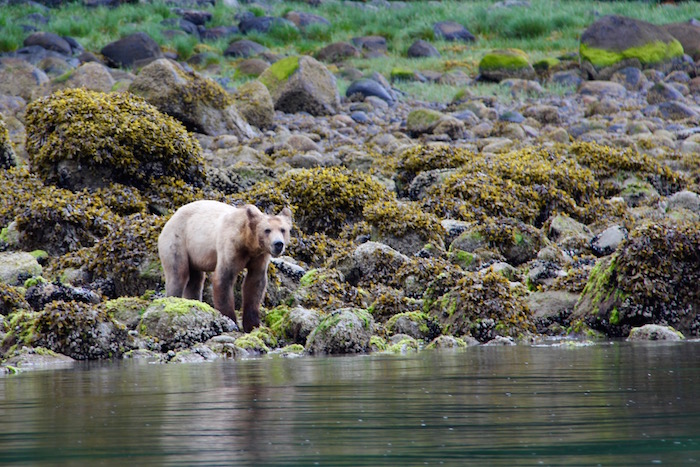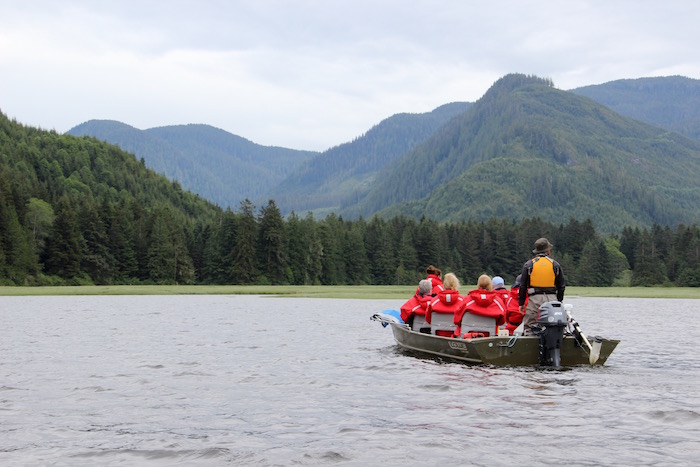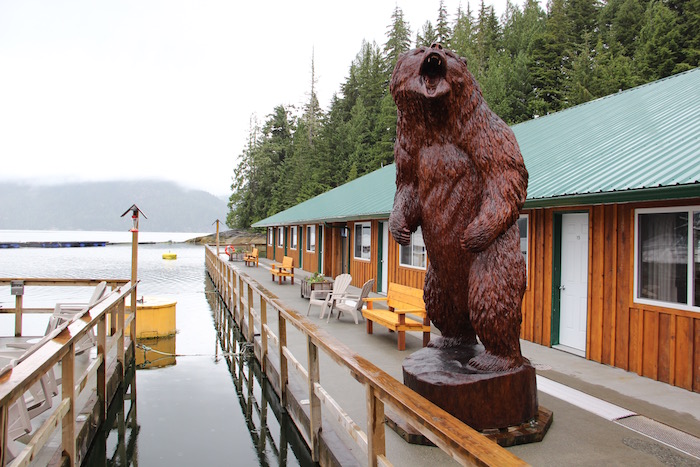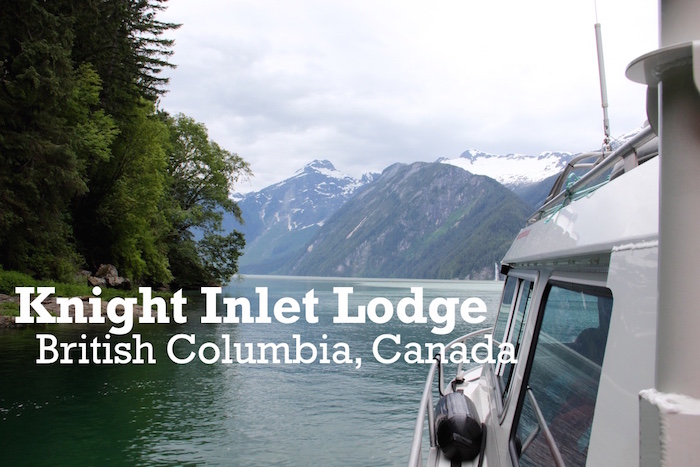A Novice’s Guide to Bear Watching in British Columbia. 10 Things You Need To Know.
 As my sightseeing boat drifted closer to the lush green sedge-covered bank in the estuary down stream from Knight Inlet Lodge, I could see the head of the Grizzly Bear scanning us above the vegetation. The enormous beast had risen on his back legs; thick front paws hanging over his chest to observe our approach. He appeared to snort the air often as we drew closer. My brain reminded me that earlier in the day the guide on our bear tracking trip, Jason, had told us that bears have an incredible sense of smell – up to seven times more than a blood hound. This is how they sense the presence of animals – including humans.
As my sightseeing boat drifted closer to the lush green sedge-covered bank in the estuary down stream from Knight Inlet Lodge, I could see the head of the Grizzly Bear scanning us above the vegetation. The enormous beast had risen on his back legs; thick front paws hanging over his chest to observe our approach. He appeared to snort the air often as we drew closer. My brain reminded me that earlier in the day the guide on our bear tracking trip, Jason, had told us that bears have an incredible sense of smell – up to seven times more than a blood hound. This is how they sense the presence of animals – including humans.
I wondered if my failure to take proper notice of the request to avoid perfumed body sprays and toiletries was what this creature was sniffing out. It got me thinking about all the things that I had learnt that could help other novices, and people like me that are more used to city breaks, when going bear viewing in British Columbia. The result is this guide.
1: Why should you go?
The best way of describing why you should go is in my article “Why Did Grizzly Bear Viewing Convert A City Boy To A Wilderness Lover?” Most of the people I met on my trip were doing it as a long-held bucket list thing to do. Many had harboured the wish to see bears in the wild from childhood. They were fascinated by their lumbering beauty and unusual life, which involves annual binge eating followed by hibernation, which makes them only available to see for a relatively limited part of the year.
I did not share this passion before my trip but came away with one of the most memorable and beautiful experiences I ever had on a vacation. The remoteness of the countryside is breath-taking, and getting to see the creatures immersed in this almost fantastical and calm environment is delightful. It gave me a different perspective of the world. I saw it touch everyone the same way.
It is also one of the few accessible places in the world where you have to disconnect, as there is no Internet or mobile phone access!
2: When should you go?
The peak season for viewing bears is in the autumn months (mid-August to end-October) when salmon are heading up the rivers and the bears congregate there to gorge on the constant flow of food. They shovel down vast quantities to fatten themselves up for their coming hibernation. You view them from 12 people sized viewing platforms built around the rivers during at least two of the two-hour available periods (7:30 – 9:30, 10:10 – 12:00, 13:30 – 15:30 or 15:30 – 17:30).
A quieter and less expensive time, is spring (late-May to mid-August) when bears head down from their dens high up in the hills. They can be found ferreting around the banks of the coves, especially at low tide, eating on the sedge grass and flipping over rocks to find bugs and muscles. Viewing is in small flat boats holding around six guests and a guide.
I visited at this time and, although you do have to go out seeking bears, I saw them on every outing and was able to get up to 50 metres close. This is the distance that Knight Inlet maintains to make sure the bears are not spooked or intruded upon, and so they usually totally ignore the boats. The exception was the large male we saw. They tend to be reticent about human presence and stay out of sight, except when pursuing females in the mating season. Something that the ladies use to their advantage when they want to keep pesky males away from them, or their cubs, by staying within closer proximity of human presence.
Due to weather, and lack of bears, the lodges close from November until towards the end of May.
I really enjoyed the quieter spring trip and can recommend this time.
 3: Where should you go?
3: Where should you go?
I stayed at Knight Inlet Lodge in Glendale Cove, which is a half hour floatplane trip from Campbell River on Vancouver Island. I loved it.
Knight Inlet Lodge has been operating on the same site in Glendale Cove since 1979 when its founder, Blair McLean, dragged his fast-growing salmon fishing lodge on a series of floats to the spot from Hoaya Sound many miles away. This remote area had been uninhabited since the small 150-employee self-contained Glendale salmon canning plant closed in the 1940s. The lodge became focused on bear viewing after the Wyatt family bought it in 1996. It now hosts 2,000 guests a year, mostly from Europe, Australia and New Zealand, during the season that runs from end-May to November. The family set themselves a mission to protect the environment and the bears, by providing “Grizzly bear viewing and stewardship”. Their activities include a “Stop The Hunt” campaign and purchasing the annual licence granted to hunt bears in the region since 2006. That fee is at least $30,000 a year and guests support this by buying various Knight Inlet merchandise, like aluminum water bottles and rubber wristbands. They also host and support university researchers studying bears.
Watch my video overview of Knight Inlet lodge and what to expect from a stay there:
Another lodge you could consider is Great Bear Lodge. It is a smaller lodge with a similar eco ethos and service.
4: How long should you stay?
Knight Inlet Lodge offers packages that include a night in Campbell River, close to the float plane station, and then two or three nights with them. I recommend going for three nights as this allows you to pace your time without worrying about missing out on anything.
You can take part in four daily activities and the days are busy with little downtime. There will be two bear viewing activities and then you chose from other activities including a kayak tour, 20-mile speedboat trip to Glacier Bay to view waterfalls and the mountains, a bear-tracking walk deep into the forest to follow their paths and see trees they mark and scratch and the “Walk Above The Clouds”. This is a walking platform high up one of the mountains with views of Glendale Cove, Knight Inlet and into a Bald Eagle’s nest.
If you stay for three nights you have time to relax on the decks and enjoy the scenery in addition to all the outings. As this may be a once in a lifetime activity make sure you grant it enough time.
 5: What will you actually see?
5: What will you actually see?
Although the main reason for going is bear viewing, you should see a range of wildlife. On my trip I saw grizzly bears of all ages, black bears, Bald Eagles, Pacific White-sided Dolphins around six feet long playing around our boat, a passing Humpback Whale, Seals and heard a wide range of other bird life, including a determined Woodpecker hammering away on our bear tracking trip.
I saw bears every time we went out on the viewing trips. In the peak season you will likely see more in terms of numbers as they are congregating around the river.
6: What is included in the price?
Pretty much everything, including the flights, accommodation, meals, snacks, soft drinks including tea / coffee, excursions and the use of waterproof and warm gear. The only added costs are alcohol drinks (other than wine included with dinner) and any items you buy from the gift store. In Knight Inlet it is open for half an hour after dinner. It sells branded clothing and other goods to support their “Stop The Hunt” campaign.
You should budget for tips, which you place in an envelope and leave at the desk on check out to be shared with the entire team.
There is no Internet or mobile phone access, and so no costs to be incurred for that!
7: Is the float plane ride to the lodges really scary?
No. Take a look at the video I made of the flight to and from Knight Inlet Lodge to help address any fears you may have.
There were many nervous flyers looking and sounding tense before we boarded the small plane. However, once we drifted up into the sky and the panorama below us could be viewed, everyone relaxed and enjoyed it. On our trip one of my colleagues terrified of flying agreed the ability to see the beauty below was the distraction that overcame her fears.
When the weather is more changeable it can be bumpier than my flight. If you are nervous take a motion sickness remedy to calm and reassure you.
8: What should you pack?
Much less than I thought! The float plane restricts luggage to 14kg (30 pounds) and prefer soft cases and duffle bags to hard-sided cases, as they are stowed in the floats and in a small storage space at the rear of the plane. Those in the know travelled with just a rucksack and had plenty to cover them for the few days there. I recommend you follow this approach. You leave unneeded cases at the floatplane terminal for collection on your return.
As all the waterproof, warm gear, wellington boots and binoculars you may need are provided at the lodge you need to bring very little. Dress code is informal at all times and there are no laundry facilities, so I recommend packing the following:
- Good walking shoes or boots.
- Comfortable shoes for hanging around the lodge such as flip-flops.
- Fleece to wear in evenings or day around the lodge if gets chilly.
- Light waterproof jacket with hood.
- Sufficient changes of underwear and socks.
- Birthday suit or whatever you sleep in! The duvets are nice and plump and cosy.
- T-shirts or casual shirts for each day.
- Change of trousers on the off chance the ones you wearing get grubby or wet. If clothes do get wet you can leave them in the heated outdoor gear room to dry them.
- Necessary toiletries and shaving gear. These should ideally be no or very low perfume variants. Shower gel and hand wash are provided in the bathroom.
- Sun protection including hat and cream.
- Basic first aid remedy kit of your preferred treatments for headaches and other ailments.
 9: What camera equipment should you take?
9: What camera equipment should you take?
Based on my experience, you should make a choice on whether you want to be a well-prepared wildlife photographer, with the equipment to match, or just be an observer. If the latter, I suggest asking others using the right equipment if they will be willing to share their images with you to show people back home, and to remind you of what you have seen. Most people will be flattered to be asked for copies of their photographs if you ask the right way. I know I am, and happily share them on sites like Flickr and Facebook for people who want to see them.
There is not really any middle ground, especially when viewing the bears in the spring from boats. The closest you get is 50 metres away and so need a zoom lens of 300mm or more to get great shots. You also need to know how to use it, especially if the boat is bobbing about a bit. Many people left their cameras back at the lodge after the first outing as they realised they needed something more powerful. Wildlife photography is a skill and needs expertise in fast aperture speeds, zoom lens and so on.
If you are taking camera equipment remember that you are in a rainforest and it will be wet! So make sure you have good waterproof protective covers for your camera and I recommend a camera lens hood to keep water drops off it. You cannot use a flash when around the bears.
10: How do you get the most out of time there?
Here are some quick additional tips for getting the best from your stay:
- Assume it will be wet and be prepared. It is a rainforest and gets up to 3 metres of rain a year.
- Go on every excursion type offered. They have been running them for years and know what works. I was sceptical on some and loved them all.
- Listen to the guides. They will brief you on what to do if you come across a bear and pay attention to avoid any issues.
- Double check your gear before you head off on an excursion. People had forgotten they had treats like Tic-Tacs and gum in their pockets. It is important not to take alien smells and stimulus into the environment.
- Talk to your fellow guests. They are an interesting group and you may get some good additional British Columbia sightseeing and travel tips, plus they may share their great photographs!
- Attend the after dinner talks. They are only half and hour and I learnt so much about bears and the region. They are entertaining and engaging.
- Support the “Stop The Hunt” campaign by buying some of the merchandise and help keep the region and bears welcoming of human presence without fear.
Final thought
I hope my guide to bear watching as you prepare and head off, as a novice, to experience this memorable trip has been helpful. If you have any suggestions please add them to help others. And me for my return trip that I hope will be soon!
Inspired? Find out more about bear viewing at Knight Inlet Lodge in British Columbia.
I travelled as a guest of Destination Canada in partnership with Travelator Media
Further reading about bear viewing:
- Grizzly Bears of Great Bear Rainforest
- Land of the Grizzly: Canada Great Bear Rainforest
- Gizzly Bear Viewing Knight Inlet
- Detox with the bears of British Columbia
Discover more from Tips For Travellers
Subscribe to get the latest posts sent to your email.













Excellent tips Gary especially about the photography. It can be tempting to spend a lot of time taking photos and not actually enjoying the experience of really seeing the bears.